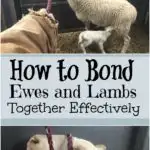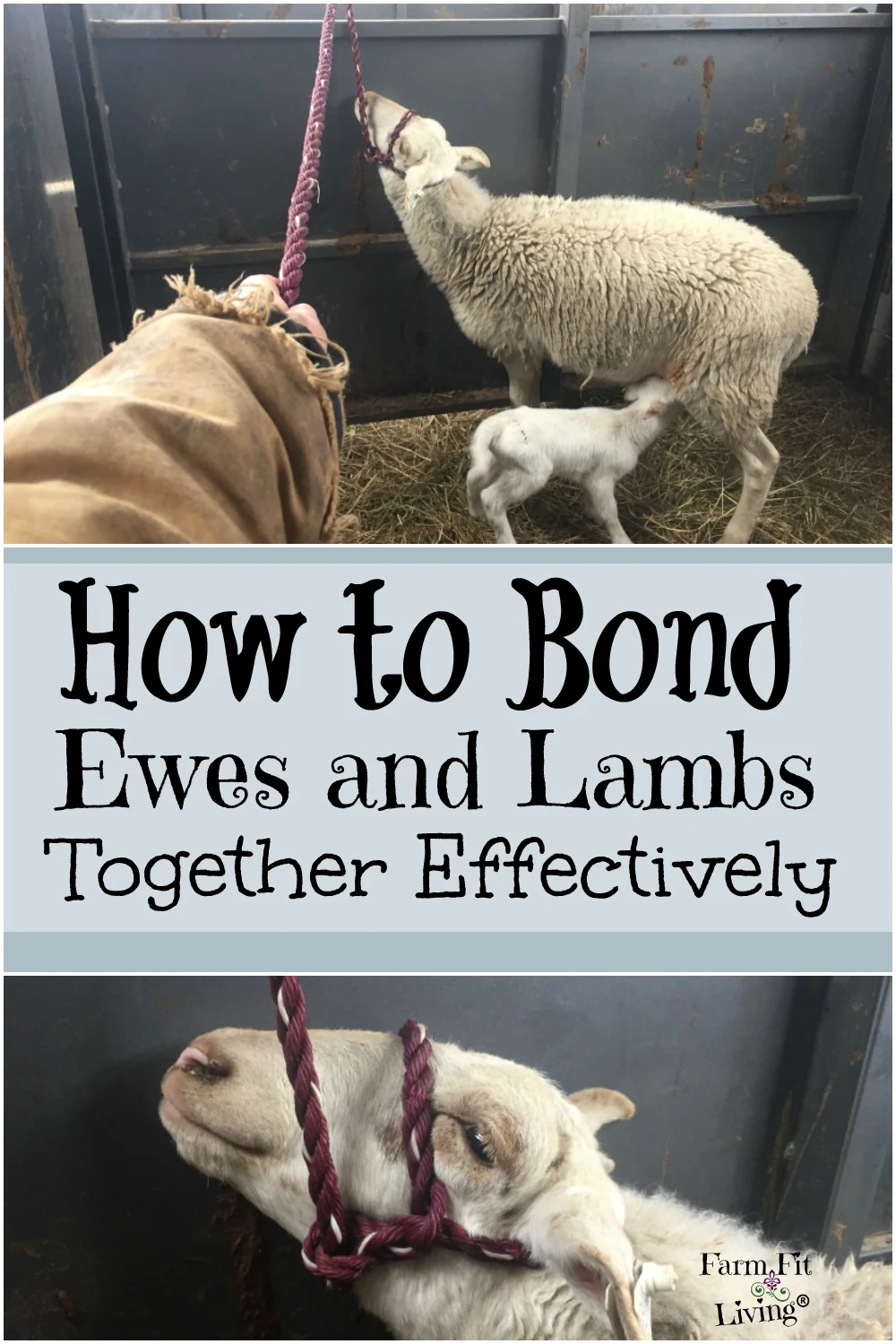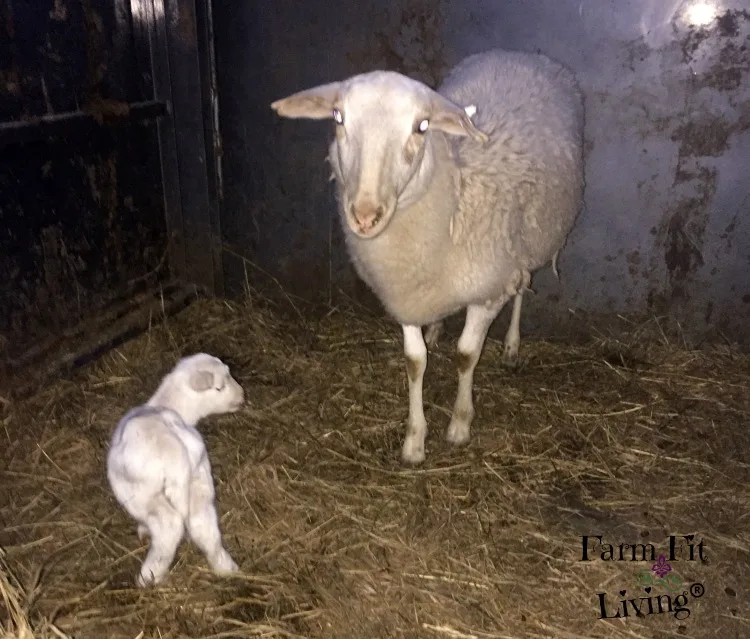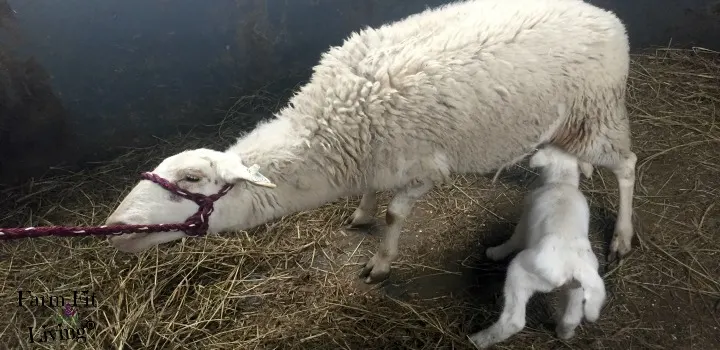Are you looking for how to bond ewes and lambs together more effectively?
How to bond ewes and lambs together is a topic I see very frequently among sheep producers. It’s a very common practice and always super necessary when the bond is broken. The ewe-lamb bond after lambing is super important.
The breed of hair sheep I raise is super prolific and maternal. I rarely have issues with a mother rejecting her lamb. But I HAVE had issues with a mother rejecting her lamb! It can happen no matter what breed of sheep you have. So, I have a “how to bond ewes and lambs together” procedure I turn to for times like these.
If that ewe-lamb bond is broken for some reason, the lamb will be rejected by mom. And maybe even put in danger.
However, there are things that the sheep producer can do to reunite and rekindle that special bond between ewe and lamb. It takes a lot of time and it’s not always very easy. But the how to bond ewes and lambs together process I (and many other producers use) is super effective if you can be more stubborn then the animals involved.
Listen to the Podcast Episode:
This post contains Affiliate Links. This means if you click and buy, I might make a commission at no cost to you.
See my policy for more information
So, Why Even Bother With Bonding?
Because it has been proven to be very effective. The “how to bond ewes and lambs together” procedure I recommend works 85% of the time. This method keeps families together and prevents lambs from needing to be bottle fed.
But, it is very time consuming and requires some physical strength. And the other 15% of the time, the mom is just done and absolutely will not respond to the bonding procedure.
So, why not just give up right away and just put the lamb on a bottle? There are a few reasons to try to promote the ewe-lamb bond:
- Healthier Lambs long term (My own opinion).
- It is very possible to rekindle the relationships.
- Cost of milk for the bottle (either dairy milk or powdered milk – It costs somebody money!).
- It’s a test for the ewes. If they can’t pass it, they are gone.
So, there are some positives when trying to decide if bonding is worth it. Now, let’s review the signs you might see if you think a ewe is rejecting her lambs. When you see these signs, you’ll know it’s time to implement the “how to bond ewes and lambs together” procedure.
Signs to Know If You Need To Step In
The signs are very obvious, actually. You’ll definitely know it when you see them:
- Lamb and ewe are on opposite ends of the pen.
- Lamb is crying and ewe is not responding to lamb
- The ewe is kicking at the lamb trying to nurse
- The lamb might be trying to nurse other lambs.
- Or worse…The ewe is head butting the lamb trying to kill it.
Again, the signs are pretty simple. When you see them, you’ll know that something is not right with the situation. When you’re searching for answers, you’ll want to find the procedures and tips that are tried and true.
So, talk with your mentor. Your expert mentor will know how to help you find the right bonding procedure that works for you.
Bonding vs. Grafting
You might relate the term bonding to another term called grafting. The two terms are similar in their meaning.
Bonding is simply reuniting and building a relationship between the ewe and her own lamb. It’s fairly simpler to accomplish the bond with the procedure later on in this post.
Grafting is uniting and building a relationship between a ewe and lamb – not related. So, if a ewe lost her lamb and another ewe had triplets, I could graft one of the triplets onto the ewe without a lamb. How easy is it to do this?
Check out this post I wrote about grafting a kid onto a doe using skin and baling twine. It should work the same way. When I get an opportunity, I will write a post for grafting a lamb.
And that’s what you need. An opportunity. For grafting, you need the skin of the dead animal or you need the baby to smell like the old baby. There’s some other products and ways, but the skin method worked within a day.
Also, the main reasons the “how to bond ewes and lambs together” procedure works is because letting the lamb nurse the mother will:
- Allow the lamb to ingest mother’s milk, resulting in smelling like the mother’s baby with time.
- Encouraging the ewe to continue to produce milk.
So, the relationship between the two is that bonding is the first step. And they need to be in close quarters together to be forced to bond together.
What Does A Bonding Pen Look Like?
First of all, you need a secure pen to bond ewes and lambs. The mother will not like being in there at first and will try to escape.
Baby will also try to escape an aggressive mom. Here are some tight and secured bonding pens I’ve used for both ewes and goats:
- A large dog kennel. I led the mom and babies out to nurse. Then, I put them back.
- Half of our livestock trailer. Works if the separation gate is solid. Otherwise, baby will escape.
- 5X8 Foot Pens using hog panels or woven wire. Must be tightly secured at the bottom.
- A small sized pen with solid sides.
- I’ve also made a bonding pen out of old pallets.
The main goal of the bonding pen to bond ewes and lambs is to act as a secure and isolated area for the family to be together without any distractions. And to change the mindset of the ewe.
Her mindset should change to loving or needing the lambs to nurse her. And you can help with that by gently guiding and encouraging the lambs to nurse on a schedule.
Here’s What You Need for Bonding
So, this is what you need for the procedure of tying up the ewe to allow the lambs to nurse. Besides a pen, you need just a few other things on hand during lambing season:
- A halter fitted comfortably on the ewe
- Hay and Water for Mom
- Time every four hours or so to work with the two.
They will be by themselves the majority of their day. However, you’ll still need to make sure the mom is feeding the baby. The next steps are the exact process I use for how to bond ewes and lambs together.
Here’s How To Bond Ewes and Lambs Together
Once the new family is in their bonding pen, it’s time to begin the bonding process. I usually let the ewe and her lambs hang out together for a little while.
Then, I step in. There’s the procedure I use and I’ll now teach you how to bond ewes and lambs together.
First of all, the halter goes on mom. It should fit her comfortably around her ears and high on her nose. You don’t want to hurt her or make her feel uncomfortable with the process.
And, please do not put a rope around her neck! Because there is too much of a chance she could become too stressed, flip over and strangle herself.
Ok, so then you need to tie her head up high. Stay right there with her with your hand on the halter. With the other hand, move the babies towards the teats. It’s kind of like the game of Twister.
If the ewe is kicking a lot, you’ll have to hold her legs down. She won’t like this, but you’ll have to just stay strong and show her who is boss, but in a gentle way. I’ve found ewes to not be as bad about the kicking like goats are.
So, then, just let the lambs nurse. You’ll need to wait until the lambs have had all they want. Then, carefully untie mom and give her some hay. Repeat this process every 4-6 hours until you can trust the ewe and lamb together. It has always taken me a few days for a family to bond.
When Should You Give Up on the Process?
The bonding process takes some time. How much time is not guaranteed. It simply depends on the ewe herself and how she responds.
And the most successful bonding period typically takes less than two days. Consequently, you could spend up to two weeks or so and the ewe will never accept her baby and feed it on it’s own.
Also, you have to ask yourself this question: Do I really want to spend more than a week or two trying to get this ewe to accept her baby? If your answer is no, then go with that. There are other options for rearing a baby. It doesn’t have to live on it’s mom’s milk.
A good milk based lamb milk replacer is totally fine. The lamb will grow very well on it.
But, I still always give the advice to try the bonding procedure for up to 3-5 days before giving up. And stay strong. Here are some ways to try to prevent the ewe from rejecting her babies.
Why Did the Ewe Reject Her Baby?
Typically, this happens because a ewe and baby are separated for some reason. Or, the ewe is a first timer who needs a little assistance.
So, what can you do to prevent rejection from a mother ewe?
- Have bonding pens set up and ready to go.
- If the ewe is showing some lambing signs, you can just put her in one for the night.
- Keep rams separate. For some reason, rams think the ewe that just lambed is ready to breed again.
- Finally, make your lambing pens plenty big with enough room for a lambing ewe to have some space.
I hope this information helps you to make some good decisions.
Thankfully, It Won’t Be Every Single Ewe
Rest assured that not every ewe in your flock will have issues with rejecting lambs. Depending on what breed you raise, most of your ewes will be loving and excited to be moms.
However, you must understand that sometimes, the immediate bond between ewe and lamb could possibly be broken. And that there is a chance you can promote the mindset of the ewe to change. Now you have some tips and a procedure to use in case it does happen.
Anything can happen. And with time, you will experience this. I hope it helps you to find success in making your lambing season just a little bit easier!
Have A Happy Lambing Season!







How to Bottle Feed a Lamb Successfully | Farm Fit Living
Monday 12th of March 2018
[…] Maybe mom just doesn’t want it. She refuses to respond to the bonding process. […]